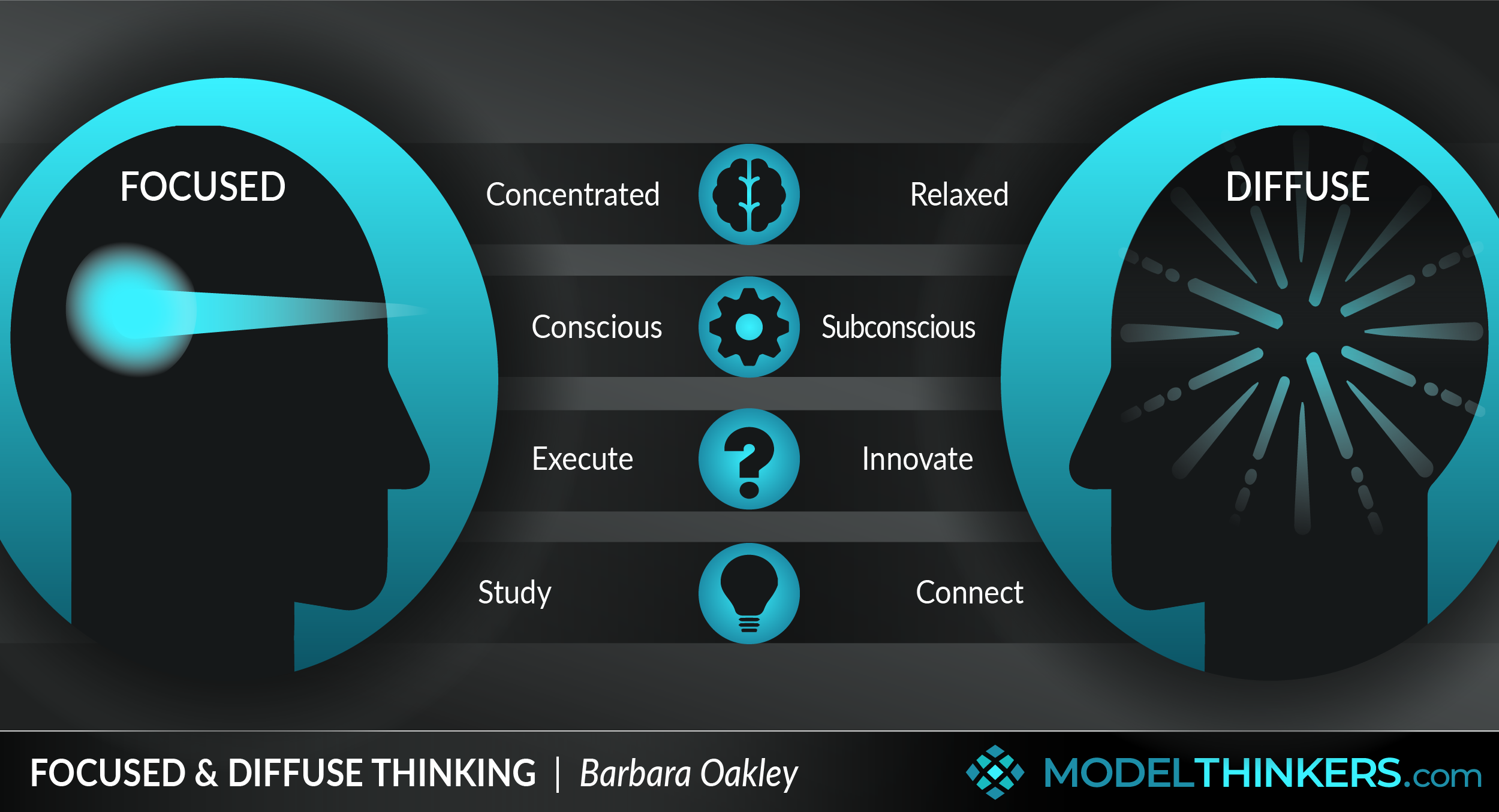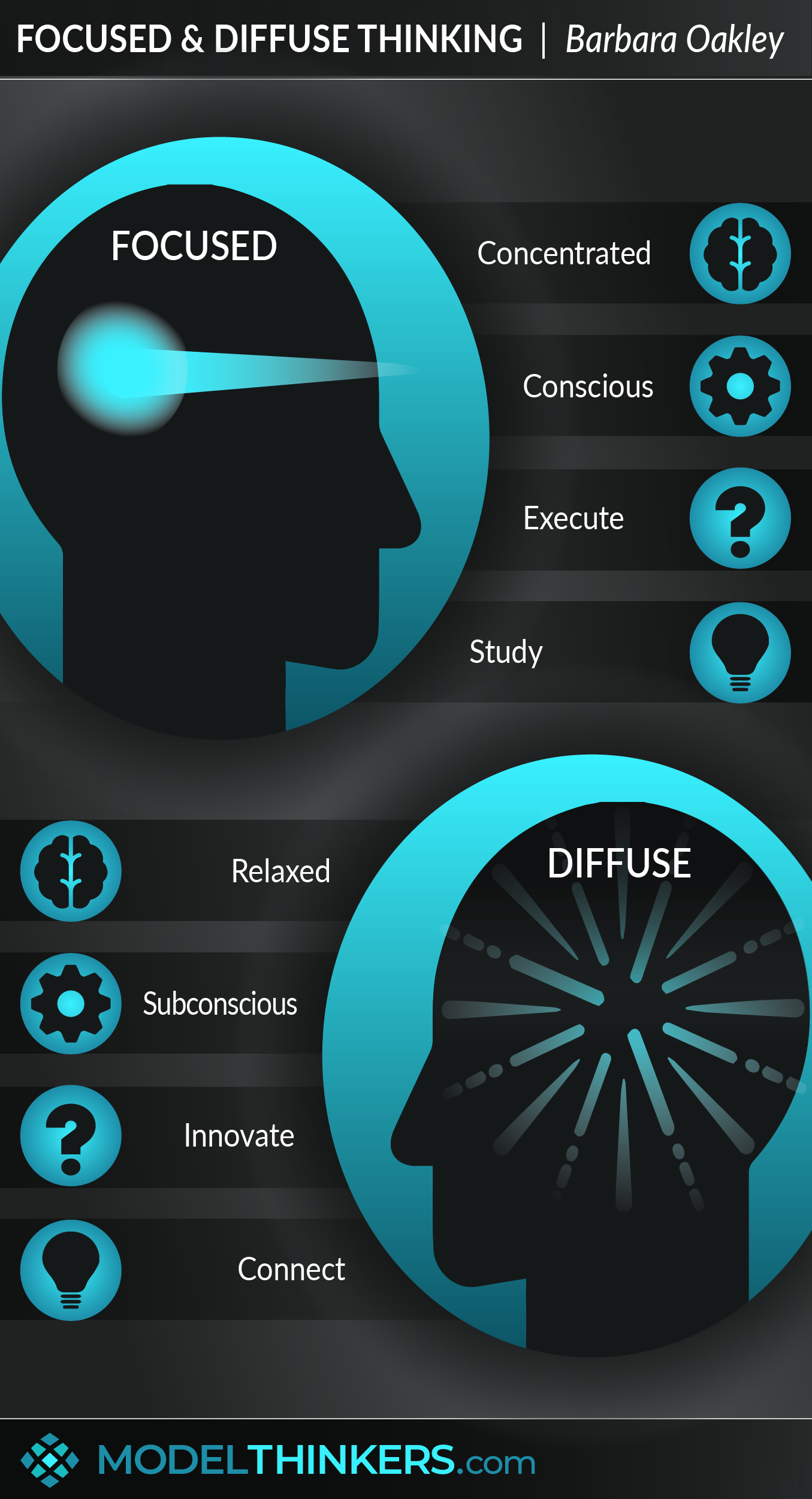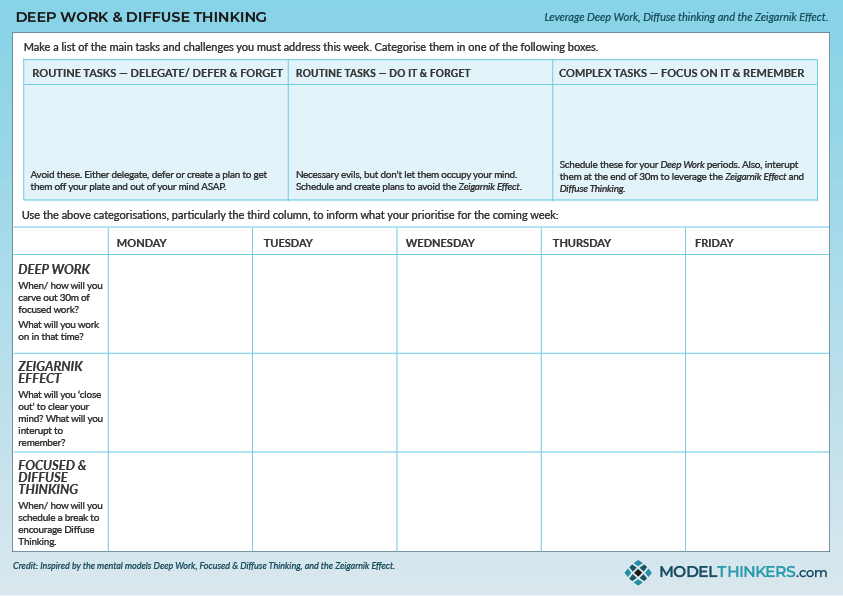

 0 saved
0 saved
 116.2K views
116.2K views








Imagine that you’re trying to solve a challenging problem or learn a difficult new concept. Your obvious move would be to concentrate on it until you come up with a way forward, right? Well, this model suggests otherwise.
Focused and Diffuse Thinking describes two counterposed methods of approaching problems and learning. Focused Thinking is concentrated, conscious and relatively predictable. By contrast, Diffuse Thinking is relaxed, occurs largely subconsciously, and can result in surprising connections.
FOCUSED THINKING.
Barbara Oakley, the academic and author responsible for popularising this model, describes Focused Thinking as dependent on established neural pathways and existing thought patterns. It’s the type of thinking you access to understand and solve familiar problems as well as to study a concept.
The strength of Focused Thinking lies in its ability to analyse and solve problems in a sequential manner. It’s likely you’re applying a level of Focused Thinking as you read these words and try to understand this model.
DIFFUSE THINKING.
Diffuse Thinking is what happens when your mind relaxes, providing space for daydreaming and wandering thoughts. That's something that many people miss or undervalue — it's the fact that even when your conscious mind stops concentrating on something, your brain will continue to process, ponder and think.
Rather than being focused on a defined path, Diffuse Thinking allows your subconscious to make unexpected connections between disparate ideas. As a result, it can help you to develop innovative solutions and learn by connecting new and unfamiliar concepts with existing ones.
You’ll often experience Diffuse Thinking when you go for a walk, have a shower, take a long drive in the country, or just stare out the window.
A QUICK WATER METAPHOR.
Still not clear about the difference? Well, if your thought process was water, Focused Thinking would involve shooting a thin jet of water that was directed, powerful and aimed in a single, predictable direction. By contrast, Diffuse Thinking would be akin to a sprinkler, shooting mists of water in all directions, covering more ground in a lighter, unpredictable pattern.
POWER IN THE COMBINATION.
So which is better? Oakley explains that the trick is not to choose between the two approaches, but rather to cycle between Focused and Diffuse Thinking for the greatest impact.
Back to working on that challenging problem? Use Focused Thinking to rationally explore it and consciously define the real issue at hand. Then let your brain relax into Diffuse Thinking, allowing your subconscious mind to process and play with the ideas in your head and potentially come up with innovative solutions as a result.
Want to learn a difficult and unfamiliar concept? Study it with Focused Thinking, then let your brain shift into Diffuse Thinking. The combination will allow you conscious brain to investigate the concept, while your subconscious mind forms new links and connections to embed it into your memory and thinking.
THINKING HACKS FROM DALI AND EDISON.
Ever had a brilliant idea as you’re falling asleep, only to find it wiped from your mind when you woke up the next morning? Both Salvador Dali and Thomas Edison did too — only, rather than being annoyed, they found a way to take advantage of it.
Dali and Edison were independently aware that the transition between a wakeful conscious mind and deep slumber represented a powerful, creative space. They’d frame a challenge with Focused Thinking, fixing an idea or problem in their minds, before letting themselves start to fall asleep and enter Diffuse Thinking.
However, rather than surrendering to sleep, Dali and Edison were said to use a heavy key and a handful of ball bearings respectively, to snap them back to wakefulness and Focused Thinking. This combination allowed them to capture their subconscious memories and connections. See the In Practice section below for more and we should note — Oakley is quick to point out that while Dali talked about this approach, the Edison story is a bit of legend and has not been verified.
IN YOUR LATTICEWORK.
You might have noticed that this model bears some resemblance to Fast and Slow Thinking, one of the foundational models behind behavioural economics. Though very different for their takeaways and implications, these models easily co-exist with each other. For example, Focused Thinking can be thought of as a form of Slow Thinking, and Diffuse Thinking as a form of Fast Thinking.
Beyond that, consider using Focused and Diffuse Thinking in combination with other learning themed mental models such as Spaced Retrieval, Deliberate Practice and Double-Loop Learning. Use it to support innovative thinking as part of Framestorming and in combination with Temporal Landmarks to create a clear break between extended Focused and Diffuse Thinking sessions.
This model is a useful companion with Deep Work, in fact, you can see how Cal Newport, the creator of Deep Work, incorporates a form of Focused and Diffuse Thinking into his routine via the In Practice section below.
If you want to try to influence your Diffuse Thinking, while you can't by definition do it consciously, you might want to apply the Zeigarnik Effect, by interrupting your work before you finish it including leaving a key question unanswered. Be sure to use the canvas at the bottom of this page for practical help in combining Focused and Diffuse Thinking, Deep Work and the Zeigarnik Effect.
Finally, one of the most practical ways to consistently apply this approach is through the Pomodoro Technique.




-
Use the canvas.
Use the canvas at the bottom of this page which combines this model with Deep Work and the Zeigarnik Effect in a practical, weekly application to improve your working week.
-
Switch between Focused and Diffuse Thinking.
Whether you’re trying to solve a complex problem or learn an unfamiliar concept, consider beginning with Focused Thinking to define the problem or concept, before switching to Diffuse Thinking to let your subconscious mind continue to process and make further connections.
-
Take more breaks.
It’s true that sometimes you can’t solve a problem by attacking it head-on. This model is a reminder that if you’re working on a major challenge, sometimes its best to ‘sleep on it’ and let your subconscious mind have a crack at it. This can be applied more broadly to interspersing walks, play, and moments of cognitive rest into your work schedule so you can better flip between the two thinking modes.
-
Use a trigger to move into Diffuse Thinking.
Don’t leave it to chance, experiment with various triggers or cues that help you shift into Diffuse Thinking, essentially leveraging the Habit Loop to help make the switch. You might want to consider showers, walks, riding a bike, long drives, meditation, yoga, tai chi, washing dishes or anything that works for you.
-
Use the Pomodoro Technique.
The popular Pomodoro Technique is a practical manifestation of this model and involves deciding on a task and then setting a timer for 25 minutes of Focused Thinking and work on that task. After that period, you take a 5-minute break where you can relax and enter Diffuse Thinking.
There are no obvious limitations to this model. It’s quite established that our concentrating and focused mind will not identify diverse and innovative connections when compared to our mind at rest and even play.
Similarly, it has been demonstrated that consistent work, without breaks, essentially constricts your creativity. And that moments of insight and diverse connections often do come when your mind is at rest.
Perhaps the biggest challenge is relying on it. Firstly, there's being able to readily access and even direct Diffuse Thinking, as it can be understandably challenging to consciously access your subconscious.
And, even once you access Diffuse Thinking, there's no directing it. It is, by definition, subconscious and undirected. Certainly, your obsessions during Focused Thinking will inform it, but ultimately you have no control of what will or will not arise after letting your mind wander in the shower or on a walk.
Dali and Edison.
Oakley describes how people as diverse as Salvador Dali and Thomas Edison used this approach. Dali employed a method he described as ‘slumber with a key’ which involved him sitting in a favourite bony Spanish styled armchair while holding a heavy key over an upside-down plate.
Dali would think of issues he wanted to explore, using Focused Thinking, then let himself fall asleep as he pondered them. The transition from wakefulness to sleep was a ripe period for Diffuse Thinking and, before he could forget what came to mind, his key would drop and crash against the plate to wake him up and let him capture those thoughts back in Focused Thinking.
While not verified, legend has it that Edison used a similar method, fixing a problem in his mind as he sat in a chair holding a handful of ball bearings. He’d begin to fall into sleep, drop the ball bearings, and snap back in time to capture his thoughts.
Cal Newport.
Newport is the originator of Deep Work and has rallied against the negative impact of our technologically distracted world and the powerful potential of deep, focused work. That said, he seems to inherently incorporate this model into his approach.
“When I’m trying to solve a theoretical computer science proof, the rituals I use almost always involve various walking routes around my town,” Newport explained, which points to his use of Diffuse Thinking and subconscious problem solving for complex problems.
In contrast, when Newport writes he takes a different, more Focused Thinking approach: “In my house, I had a custom library table built that was reminiscent of the tables at the university library where I used to work as an undergraduate. It had brass library lamps next to the dark wood bookcases. When I sit there, writing, I have a bright light shining right down on the desk, and it’s just me and my computer.”
This approach also adds elements of the EAST Framework and even the Habit Loop to cue his Focused Thinking.
d
The approaches behind this model have been understood and even put into practice for some time. That said, I’m attributing it to Barbara Oakley — not because she invented it or even discovered it, but she seems to be the first person who tied it together in such a clear model and has worked hard to popularise it.
Oakley tends to use evolutionary biology to explain the model. Pointing to vertebrates needing both Focused and Diffuse Thinking to survive — Focused Thinking for foraging for food or caring for offspring and Diffuse Thinking for staying safe and scanning the area for threats.
Oakley explains: “A bird, for example, needs to focus carefully so it can pick up tiny pieces of grain as it pecks the ground for food, and at the same time, it must scan the horizon for predators such as hawks…. If you watch birds, they’ll first peck, and then pause to scan the horizon—almost as if they are alternating between focused and diffuse modes.”
Find out more about Barabara Oakley via her books, including A Mind for Numbers where she explores this model along with other learning strategies, at her website.
 My Notes
My Notes
Oops, That’s Members’ Only!
Fortunately, it only costs US$5/month to Join ModelThinkers and access everything so that you can rapidly discover, learn, and apply the world’s most powerful ideas.
ModelThinkers membership at a glance:






“Yeah, we hate pop ups too. But we wanted to let you know that, with ModelThinkers, we’re making it easier for you to adapt, innovate and create value. We hope you’ll join us and the growing community of ModelThinkers today.”






















































































